
|
Special Effects (F/X) - Milestones in Film 1960-1969 |
| Film Title/Year and Description of Visual-Special Effects | ||||||||||||
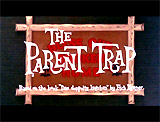
|
The Parent Trap (1961) Disney's family film, starring teen idol Hayley Mills, used the process of doubling. The story was about identical twins Sharon McKendrick and Susan Evers (both Mills), separated at birth, who met by chance at an all-girls summer camp where they became rivals. Although the screenplay originally had only a few trick photography shots using split-screen technology, the number of them were increased when it was seen how seamless the processed shots appeared. The same scene was shot twice, with filmers locking the camera in position and shooting the scene a second time. Each part of the frame was then combined onto a single negative. The film convincingly put two Hayley Mills into the same frame, but the shots were usually pretty obvious in light of recent developments in visual effects. Body doubles (Susan Henning) were also used throughout. |

|
||||||||||
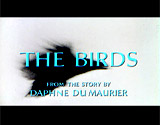
|
The
Birds (1963) Ub Iwerks was nominated for an Oscar for Best Achievement in Special Effects, but lost to Cleopatra (1963). Real birds and animatronic birds were used throughout the film. One of the film's most famous scenes was the one of dozens of birds slowly gathering on playground equipment - a complex special-effects shot that optically combined over two dozen separate elements. Shortly later during the scene of the bird-attack at the school, special effects combined the shot of the schoolhouse in the background with kids running on a treadmill in the foreground. In another frantic scene of flames and flapping, screeching birds, the female protagonist sought shelter in a telephone booth where she became trapped Advanced rotoscoping and male/female traveling mattes were used in the 20-second scene of hundreds of birds flying over an aerial view of the town - a combination of real live-action footage with hand-drawn matte paintings. |
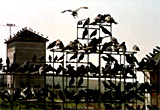  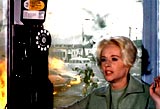 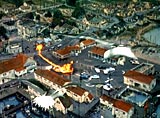
|
||||||||||
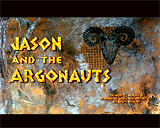
|
Jason and the Argonauts (1963, US/UK) The Ray Harryhausen-created scenes in Columbia Pictures' fantasy adventure film deserved special mention -- especially the spectacular stop-motion dueling-skeletons scene between Jason (Todd Armstrong) and sword-wielding attackers, in which life-like puppets-models were manipulated and shot one frame at a time. The four-minute skeleton fight took over four and a half months to shoot via stop-motion animation. It also incorporated rear-projected footage of the actual argonaut actors battling with swords (into thin air, actually) - the shots of the skeletons were then combined to make a realistic battle sequence.
The film was also noted for its other amazing creatures, including the gigantic moving (and creaking) bronze statue Talos (the guard of Crete), the sea god Titan holding the Clashing Rocks from destroying Jason's ship, the 7-headed Hydra, and two half-human, half-bird Harpies. |
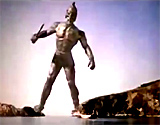 Talos Statue  7-Headed Hydra 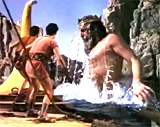 Sea God Titan |
||||||||||
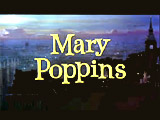
|
Mary Poppins (1964)
The musical fantasy blended live-action with animation, such as the sequence in which Julie Andrews and Dick Van Dyke frolicked with cartoon penguins, sheep and carousel ponies. The special effects technique used in the scene to combine live-action with animated characters and backgrounds was called sodium-screen (or sodium vapor) compositing - a new dual film traveling matte system similar to the blue-screen process, but using different tools. |
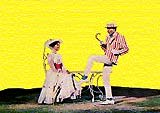 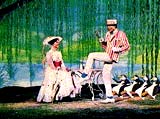
|
||||||||||
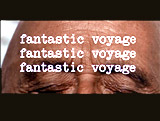
|
Fantastic Voyage (1966)
The interior of the scientist's body was created by using large, highly-detailed sets of various body parts (i.e., the brain, the heart). Through various techniques, the explorers were seen 'scuba-diving' (swimming) through the body (the actors were suspended on wires). |
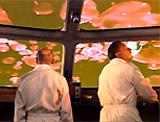 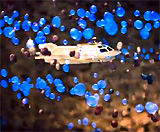 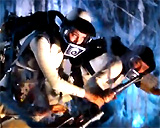
|
||||||||||

|
Stanley Kubrick's film featured the most realistic footage of space ever created - and it's still not dated by the passage of time. Miniature models of spacecraft, timer or manually-guided pre-motion control cameras, rear-projection (for the film's many video displays and computer monitors), full-sized props or models (such as the 30-ton rotating "ferris wheel" set of the spaceship), and other early techniques (such as a primitive type of "Go-Motion") were used.
In the film's opening "Dawn of Man" sequence of prehistoric apes learning to use tools on the African savannah, retroreflective matting (front projection) was used to display second-unit background scenic shots projected from the front onto a reflective surface combined with soundstage photography of actors in the foreground - a technique now replaced by computer-processed blue-screen techniques. Near the film's end in the Star Gate sequence, astronaut David Bowman (Keir Dullea) traveled through the stargate corridor in a dazzling sequence (using a slit-scan photographic technique) - a sound and light hallucinatory journey or whirling lights and colors in which he was hurled through and into another dimension - where he died and was reborn as a Star Child.
Other effects were achieved by applying different colored
filters to aerial landscape footage and a close-up of an eye, and filming
interacting chemicals. |
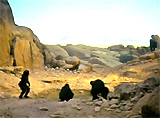 "Dawn of Man" 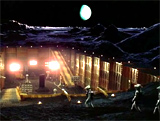  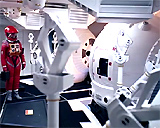 Props and Models  
|
||||||||||
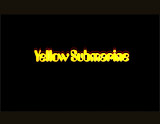
|
The Yellow Submarine (1968) |
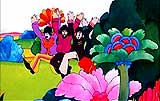
|
||||||||||